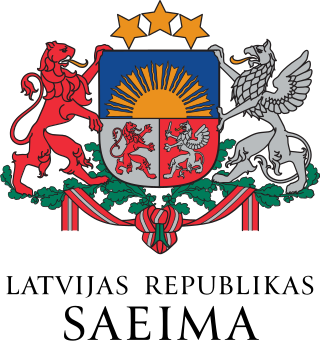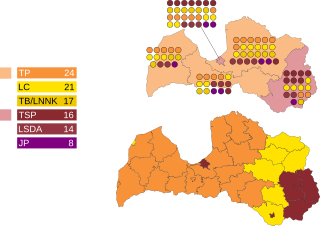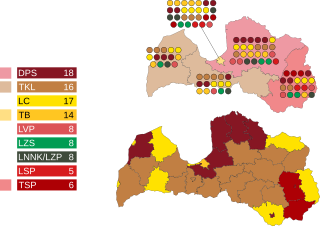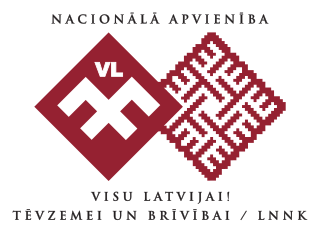
The politics of Latvia takes place in a framework of a parliamentary representative democratic republic, whereby the prime minister is the head of government, and of a multi-party system. The President holds a primarily ceremonial role as Head of State. Executive power is exercised by the government. Legislative power is vested in both the government and parliament, the Saeima. The Judiciary is independent of the executive and the legislature. The Economist Intelligence Unit rated Latvia a "flawed democracy" in 2022.

The Socialist Party of Latvia is a communist party in Latvia. It is positioned on the far-left on the political spectrum.

The Latvian Green Party is a green conservative political party in Latvia.

The Saeima is the parliament of the Republic of Latvia. It is a unicameral parliament consisting of 100 members who are elected by proportional representation, with seats allocated to political parties which gain at least 5% of the popular vote. Elections are scheduled to be held once every four years, normally on the first Saturday of October. The most recent elections were held in October 2022.

General elections were held in Sweden on 15 September 2002, alongside municipal and county council elections. The Swedish Social Democratic Party remained the largest party in the Riksdag, winning 144 of the 349 seats.

Parliamentary elections were held in Latvia on 5 October 2002. The New Era Party emerged as the largest party in the Saeima, winning 26 of the 100 seats.

Parliamentary elections were held in Latvia on 3 October 1998. The People's Party emerged as the largest party in the Saeima, winning 24 of the 100 seats.

Parliamentary elections were held in Latvia on 30 September and 1 October 1995. The Democratic Party "Saimnieks" emerged as the largest party in the Saeima, winning 18 of the 100 seats.

The Latvian Russian Union (LKS) is a political party in Latvia supported mainly by ethnic Russians and other Russian-speaking minorities. The co-chairpersons of the Latvian Russian Union were Miroslavs Mitrofanovs and an alleged Russian agent Tatjana Ždanoka.

Parliamentary elections were held in Latvia on 7 October 2006. The governing coalition, led by Prime Minister Aigars Kalvītis and his People's Party, won the election. Kalvitis's government thus became the first to be re-elected since Latvia had regained independence in 1991.

Parliamentary elections were held in Russia on 12 December 1993. They were the first parliamentary elections in post-Soviet Russia and the only time to the Federation Council, with future members appointed by provincial legislatures and governors.

Parliamentary elections were held in the Latvian SSR on 18 March 1990. It was the first free parliamentary election in Latvia since 1931 and saw 201 deputies elected to the Supreme Soviet of the Latvian SSR, 170 of them in the first round. Run-off elections were held on 25 March 1 and 29 April. The Popular Front of Latvia won over two-thirds of the vote. Unlike its Estonian and Lithuanian counterparts, the Latvian Communist Party did not separate from the Communist Party of the Soviet Union. Nonetheless, on 3 May 1990, the new Supreme Soviet re-elected the Communist Party member Anatolijs Gorbunovs as its chairman, effectively the leader of Latvia. He subsequently resigned from the party, and a year later the Communist Party was banned by the parliament.

Parliamentary elections were held in Latvia on 2 October 2010. It was the first parliamentary election to be held in Latvia since the beginning of the economic crisis during which Latvia had experienced one of the deepest recessions in the world.

Parliamentary elections were held in Lithuania in two stages on 25 October and 15 November 1992. A total of 141 members were elected to the Seimas, which replaced the Supreme Council; 70 were elected using proportional representation and 71 from single-member constituencies. Where no candidate in the single-member constituecies received more than 50% of the vote on 25 October, a run-off was held on 15 November. The first round of the elections were held simultaneously with a referendum on the adoption of a new constitution.

The National Alliance, officially the National Alliance "All for Latvia!" – "For Fatherland and Freedom/LNNK", is a national-conservative political party in Latvia.

Early parliamentary elections were held in Latvia on 17 September 2011, following the country's first parliamentary dissolution referendum held on 23 July 2011. The previous parliamentary election was only held in October 2010.

Parliamentary elections were held in Latvia on 3 and 4 October 1925. The Latvian Social Democratic Workers' Party remained the largest party, winning 32 of the 100 seats.

The Jewish National Bloc was a political alliance in Latvia in the 1920s. It consisted of Histadruth Hacionith, the Jewish National Democratic Party and Mizrachi.

The National Union was a far-right political party in Latvia during the inter-war period. It was led by Arveds Bergs.

The Polish-Catholic Latvian Union of Poles was a political party in Latvia during the inter-war period. It was led by Jānis Veržbickis.

















